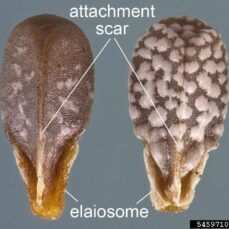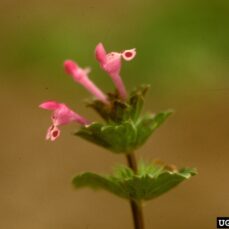Common Dead-Nettle (Lamium amplexicaule)

Photo credit: John D. Byrd, Mississippi State University, Bugwood.org

Management Strategy
Squamish
Whistler
Pemberton
Vectors of Spread
Synonyms
Henbit, henbit deadnettle, giraffe head
ID Characteristics
General: Common dead-nettle is an annual plant in the Mint family.
Flowers: Small, purple and orchid-like. They grow in clusters at the axils of the broad, stalkless upper leaves.
Stem: Square, slender, finely hairy and erect. Common dead nettle can grow to be 10 – 40 cm tall. The stems are highly branched near the base of the plant; they start out with a spreading growth habit before becoming erect.
Leaves: Opposite, rounded and heart-shaped, with coarsely blunt-toothed margins. Leaves are typically 1 – 2 cm long and 1 – 3 cm wide. Lower leaves have long stalks, whereas upper leaves are stalkless, broad-based and can be clasping at the stem. Leaves are hairy on the upper surface.
Fruit: This plant forms nutlets of 4 seeds clustered together. The seeds are light to dark brown with white spots and triangular with squared-off tips.
Roots: Short taproot that is finely branched.
Similar Species
Invasive
Purple, or red dead-nettle (Lamium purpureum var. purpureum), has triangular upper leaves and is red or purple-tinted.

Chris Evans, University of Illinois, Bugwood.org
Habitat and Origin
Common dead-nettle is native to Eurasia but has since spread across the world.
Common dead-nettle prefers moderately dry, disturbed areas. It typically grows by roadsides, in croplands, pastures, waste areas, gardens, and in lawns. It thrives in cultivated soil and does not tolerate shade.
How it Spreads
Common dead-nettle reproduces solely by seed. Each plant produces 200-2000 seeds, which can survive in the soil for up to 20 years, leading to the formation of a persistent seed bank. The plants contain both male and female flowers, so they can self-pollinate with the help of bees.
Dispersal over short distances occurs by wind and animals, while dispersal over longer distances occurs by flooding events or when birds and other animals consume the seeds.
Impacts
Ecological:
- Outcompetes herbaceous vegetation, especially in turf grasses, landscapes and newly-seeded areas.
- Threatens biodiversity.
Economic:
- Host to a range of plant pests that could affect agriculture or ornamental crops, such as beet mild yellowing virus, potato virus Y, strawberry latent ringspot virus, and tomato spotted wilt virus.
- Unsightly in turf and lawn areas.
Stop the Spread
Common dead-nettle is not yet found in the Sea to Sky region, but is found in neighbouring areas and may arrive here soon. The goal is to prevent common dead-nettle’s introduction by focusing on education and awareness. If prevention fails, the goal will become immediate eradication following the proposed SSISC EDRR protocol.
Learn to identify common dead-nettle: Use the images presented in this profile page to learn how to identify common dead-nettle.
What to do if you spot it: You can report any common dead-nettle sighting by visiting our reporting page.
DO:
- Regularly monitor properties for weed infestations.
- Ensure soil and gravel are uncontaminated before transport.
- Check wildflower mixes to ensure that they do not contain common dead nettle.
- Ensure that plants are disposed of in a garbage bag if found in floral arrangements to prevent seeds from spreading.
DO NOT:
- Don’t unload, park or store equipment or vehicles in infested areas; remove plant material from any equipment, vehicles, or clothing used in such areas and wash equipment and vehicles at designated cleaning sites before leaving infested areas.
- Don’t plant common dead-nettle in a garden, no matter how well-contained its enclosure may seem.
- Don’t move soil that has been contaminated with common dead-nettle.
- Do not compost any common dead-nettle plant parts.
Control
Mechanical
Tillage or cultivation is an effective way to control the seedlings. Small infestations can be hoed or pulled by hand.
Chemical
Numerous herbicides effectively control common dead-nettle, including aminopyralid, dicamba, glyphosate, imazapyr, metsulfuron methyl, and rimsulfuron.
We recommend that any herbicide application is carried out by a person holding a valid BC Pesticide Applicator Certificate. Before selecting and applying herbicides, you must review and follow herbicide labels and application rates; municipal, regional, provincial and federal laws and regulations; species-specific treatment recommendations, and site-specific goals and objectives.
Biological
Although common dead-nettle is a host to several crop pests, none are accepted biocontrol agents for this plant in BC.
Sea to Sky Distribution
Common Dead-Nettle Factsheet
Having trouble viewing the factsheet? Don’t worry, all the information is included on this page. You can also contact us with any questions.
References
- Centre for Invasive Species and Ecosystem Health, Henbit
- Cornell University College of Agriculture and Life Sciences, Deadnettles
- Edible Wild Food, Henbit (Lamium amplexicaule)
- Electronic Atlas of the Flora of BC, Lamium amplexicaule
- Farmers Business Network, Where Did These Weeds Come From?
- Government of Ontario, Henbit
- Invasive Species Compendium, Lamium amplexicaule (henbit deadnettle)
- Penn State Extension, Dead-nettle, Henbit & Ground Ivy – Three Look-Alike Weeds
- Plants for a Future, Lamium amplexicaule L.
- United States Department of Agriculture Natural Resources Conservation Service, Lamium amplexicaule L.
- University of California Weed Research and Information Center, Henbit (excerpt from Weed Control in Natural Areas in the Western United States)
- University of Wisconsin Horticulture Division Extension, Henbit (Lamium amplexicaule)











